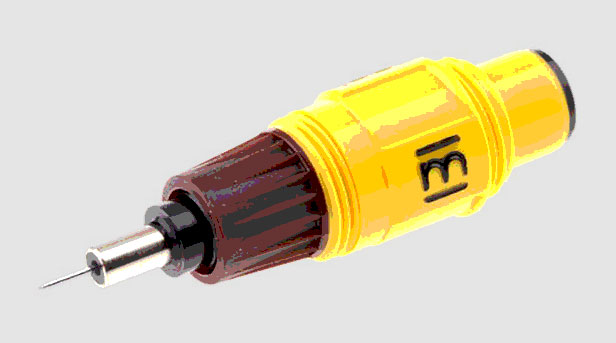
Whatever happened to...
Whatever happened to Rotring Pens?
Posted by Colin Higton
For better or worse, I have now reached a stage where when I’m asked my age in a survey I have to choose the box that says ‘50+’. As well as bringing experience, wisdom, and an inability to listen to Radio 1 without sounding like my dad – that means that when I started out as a graphic designer there were no computers, no laser printers – and the digital arts meant how well you could ‘kick’ in Subbuteo. That also means I remember when design and artwork had to be done by hand, using Cow Gum and typesetting, scalpels and steel rulers, drawing boards and the dreaded Rotring pens.
These mechanical pens were an essential part of every graphic designer’s toolbox. Their entire purpose was to make your life a misery whilst achieving something that today seems beyond simple.
Imagine you want to put a frame around an image or draw a line underneath some text – easy right? Just tell the computer how long you want the line, how thick, what colour, what position, on the level or angled, square ended or rounded or arrows or…you get the picture.

Now imagine you have to do that by hand. Literally drawing the line onto a coated paper in ultra-black ink that sits on the surface of your art paper so that you can scratch or cut away the ink at the end of the line to give a perfect square end (don’t even think about rounded).
You need a pen that draws a perfect line, at a perfectly consistent thickness. One that is available with different nibs to give a line from 0.1mm to 2mm – or any of 13 widths in between.
You need a pen that is easy and clean to use, where changing to a different width is simple, and that will work reliable every time you need it. You need a pen that will work seamlessly with your drawing board and ruler to give a perfectly level and straight line.
That was the Rotring pen – in theory.
In practice it wasn’t quite as simple…
- To get a perfect line at the desired width you had to hold the pen at exactly 90º to the paper. If you tilted it even slightly the line width would wobble or just break up completely.
- If you left the top of the Rotring pens for more than a few minutes without using it, the ink would dry and block the nib completely – and dry Rotring pens were usually dead Rotring pens.
- When you used the Rotring pens with a ruler, the ink would sometimes flow under the edge and create a terrible mess all over your artwork, your fingers, your drawing board, your ruler – just everywhere.
- Even if you drew a perfect line, the ink seemed to take longer to dry on paper than it did in the pen. So while a pen would seemingly dry up in seconds if left, that perfect line would smudge on your artwork for hours.
- Creating a corner on a box meant drawing four lines that overlapped at the corners, and then scratching the corner square by hand. Most times that worked fine – but having done 3 corners perfectly you would frequently manage to naff up the 4th.
- Nobody actually had a full set of Rotring pens (they weren’t cheap) so any lines just had to be 0.35mm, 0.5mm or 0.7mm wide. Everybody had a dodgy 0.25mm nib as well – but the thinner the nib, the more likely you were to wreck it, and the thicker the nib the more likely it was to leak, smudge or dry up.
- Most artwork was done on an angled drawing board – and Rotring pens were round – so they tended to roll off or get dropped. Dropping a Rotring pen with the lid on created a horrible mess in the lid – but dropping one without the lid on meant you might as well just chuck it away.
- Because they were an essential, someone would always want to borrow your Rotring pen – but the pen always seemed to know you had loaned it out and would sulk for days – blotching and leaking until it felt you had made amends. Of course, that might not have been the pen – just the buggers who used to borrow mine…
- All that meant that what takes about 30 seconds on a computer could take hours and hours on a drawing board. It also meant that if you created the line and thought ‘that should be thicker…’ you were reluctant to work over the top of it – and if you thought ‘that should be thinner…’ – well you just didn’t let yourself think that.
Of course it was also used to create some fantastic illustrations – and I have to say it was immensely satisfying when the pen worked and everything went right. It’s hard to look at a line on your computer screen and take the same pride in how perfect it is.
Designed in the 1920s, the Rotring pen was refined in the 1970s (not a phrase you hear often) and was a brilliant design classic – beautifully engineered in Germany.
But like photographic film, it was an essential solution to a difficult problem that has simply gone away – and on balance, I have to say I wasn’t sorry to see the back of the Rotring pen.
Back to the Blog